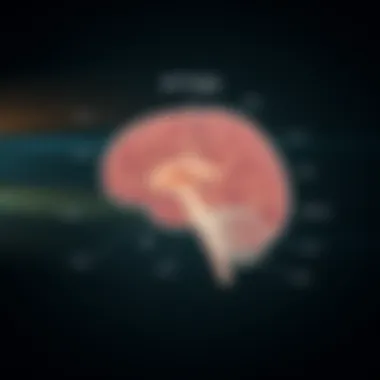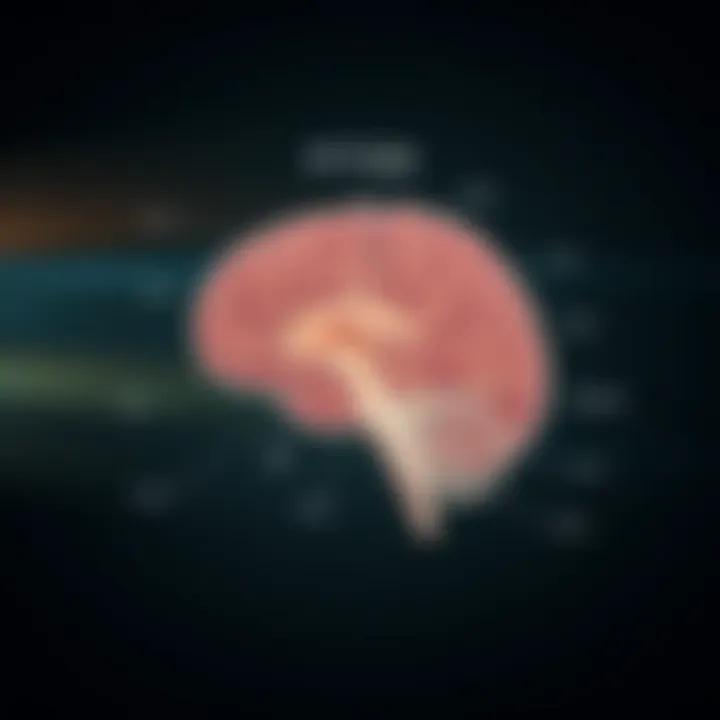Understanding the Physical Symptoms of PTSD


Intro
Post-Traumatic Stress Disorder (PTSD) is more than a label; it's an experience that can leave lasting impressions on both the mind and body. For many individuals who have faced trauma, the symptoms extend beyond the psychological realm, manifesting in physical ways that are often overlooked. To fully grasp the implications of PTSD, one must consider how trauma can twist and turn the body’s responses, leading to an array of physical sensations and problems.
Understanding these symptoms can be quite a journey, demanding not only awareness but also a willingness to confront what lies beneath the surface. Diving into this discourse offers a clearer picture, illuminating unseen struggles that accompany the diagnosed. This article seeks to delve deep into the physical sensations associated with PTSD, examining the interplay between trauma and bodily experiences, and providing insights into physiological reactions involved.
The aim is to unravel these complex symptoms, offering coping mechanisms and strategies for those who seek to reclaim their wellbeing. Let's take a step back and broaden our perspective to comprehensively understand the intricacies of PTSD and its physical manifestations.
Understanding Mental Health and Well-being
Mental health plays a crucial role in our overall well-being, combining emotional, psychological, and social aspects that influence how we think and act.
What is Mental Health?
At its core, mental health refers to our emotional and psychological state, how we cope with stress, make choices, and relate to others. Good mental health is often characterized by a sense of well-being, fulfillment, and a clear capacity to navigate the ups and downs of life. It’s not just the absence of mental illness; it’s also about how well you handle life's challenges.
The Importance of Prioritizing Mental Well-being
Prioritizing mental well-being isn’t merely a nice-to-have; it’s a necessity. Ignoring mental health can lead to a cascade of problems, both psychological and physical. When mental well-being falters, it can trigger a host of physical issues, including chronic pain, fatigue, and weakened immune response.
Common Mental Health Challenges and Disorders
Several mental health challenges can accompany or arise from PTSD:
- Anxiety disorders
- Depression
- Substance abuse
- Eating disorders
- Insomnia
Each of these disorders can overlap with PTSD, creating a nuanced struggle that can be daunting to face. Recognizing these overlaps is vital in understanding the physical symptoms that stem from trauma.
Strategies for Improving Mental Health
Improving mental health requires a proactive approach. Here are some strategies that can foster better mental health:
Self-care Techniques and Practices
Engaging in self-care is essential. This might include:
- Regular exercise
- Leisure activities that bring joy
- Staying connected with supportive people
- Practicing mindfulness and relaxation techniques
Building Resilience and Stress Management
Resilience allows individuals to bounce back from life's challenges. Practicing stress management techniques can enhance this resilience. Consider:
- Time management strategies
- Breathing exercises during moments of anxiety
- Setting realistic goals and expectations
Seeking Professional Help: Therapy and Counseling
When self-help strategies aren't enough, seeking professional help is crucial. Therapy and counseling provide the tools needed to navigate through trauma and its manifestations, guiding individuals toward healing.
Finding Balance in Life
A balanced lifestyle can contribute greatly to mental health. Here are some ways to establish that balance:
Healthy Lifestyle Choices: Diet, Exercise, and Sleep
Nutrition affects our mental state significantly. A balanced diet rich in vitamins and nutrients supports brain function. Regular physical activity not only boosts mood but also combats physical symptoms of PTSD. Lastly, ensure adequate sleep, as it has a profound effect on emotional stability.
Mindfulness and Meditation Practices
Incorporating mindfulness practices can be beneficial. Techniques such as deep breathing, yoga, or guided meditations can help ground an individual, reducing stress and enhancing focus.
Setting Boundaries and Managing Time Effectively
Establishing clear boundaries—whether in personal or professional life—can prevent burnout. Learning to say no when necessary can protect mental health and create room for personal growth.
Enhancing Personal Development
Personal development is integral to mental health, and here are some key components:
Goal Setting and Productivity Tips
Setting realistic goals serves as a roadmap for personal growth. Breaking down larger objectives into smaller, manageable tasks can create a sense of achievement.
Building Healthy Relationships and Social Connections
Social connections are vital. Surround yourself with individuals who uplift and support you, as healthy relationships can provide resilience during tough times.
Practicing Gratitude and Positivity


Fostering a gratitude practice can transform perceptions. Acknowledging small wins encourages a positive mindset, which can combat the negative spirals associated with mental health struggles.
Tips for Maintaining Mental Well-being
Here are some additional tips for maintaining mental well-being:
Strategies for Preventing Burnout
Recognizing the signs of burnout early can protect mental health. Take breaks, prioritize self-care, and engage in enjoyable activities regularly to rejuvenate.
Coping with Challenges and Setbacks
Life's challenges are inevitable. Use setbacks as opportunities to learn, adapt, and strengthen problem-solving skills.
Creating a Supportive Environment
A positive environment fosters well-being. Surround yourself with encouraging influences, declutter your space, and create a sanctuary where you can relax and reflect.
"Understanding the connections between mental and physical health is the first step toward healing, both inside and out."
Approaching PTSD with an awareness of its physical symptoms can pave the way for recovery. By integrating these strategies into your routine, you can cultivate a mindset that prioritizes mental health and nurtures resilience.
Foreword to PTSD
Understanding the complexities of Post-Traumatic Stress Disorder, or PTSD, is pivotal for both individuals affected and those around them. PTSD is not merely an emotional state; it's a condition with real physical ramifications. Acknowledging the significance of both psychological and physical symptoms fosters a holistic approach to healing. This article delves into the symptoms experienced by those coping with PTSD, aiming to shed light on a topic that often goes underappreciated in discussions about mental health.
Defining PTSD
Post-Traumatic Stress Disorder is a mental health condition that arises after experiencing or witnessing a traumatic event. The symptoms may include flashbacks, nightmares, and severe anxiety, but that’s only the tip of the iceberg. It’s beneficial to understand that PTSD can manifest physically as well. This duality of symptoms complicates the lives of those who struggle with it. They may feel trapped in a cycle of emotional distress that is deeply intertwined with debilitating physical sensations.
The Impact of Trauma on the Body
Trauma impacts not only the mind but also the body in profound ways. When someone undergoes a traumatic experience, it can trigger a fight-or-flight response, which is the body's automatic reaction designed to keep us safe.
"The body keeps the score." — Bessel van der Kolk
This phrase succinctly expresses how unresolved trauma can linger in the physical self, causing a range of symptoms such as:
- Chronic pain without a clear origin
- Increased heart rate and sweating
- Frequent gastrointestinal issues
- Persistent fatigue
Such symptoms can lead to a sense of isolation and discomfort, further complicating one's mental and emotional state. Additionally, individuals may feel as if their bodies have betrayed them, living in a state of constant awareness of their own physical sensations, which can be particularly distressing.
In many cases, individuals with PTSD report feeling as if their body has become a war zone. The lack of understanding from those who haven’t experienced trauma can exacerbate feelings of alienation. By recognizing the physical side of PTSD, one can start to appreciate the breadth of this disorder, moving beyond simply defining it by mental symptoms alone.
Physical Symptoms of PTSD
The relevance of this topic extends beyond mere awareness; it paves the way for empathetic discussions about PTSD. When individuals acknowledge that PTSD can evoke tangible physical sensations, it diminishes the stigma attached to these experiences. Moreover, comprehending these symptoms equips individuals and their support networks with the tools to address them effectively.
The physical manifestations are often overlooked in mainstream discussions, but they are essential for mitigating a person's overall distress. By merging the emotional with the physical, we can highlight the comprehensive nature of PTSD, paving roads toward recovery and encouraging those affected to seek help.
Common Physical Manifestations
PTSD can produce a diverse array of physical symptoms that can challenge an individual’s day-to-day functioning. Observing these manifestations might seem simple, but the underlying complexities reveal the intricate relationship between the mind and the body. Here are some of the most common physical symptoms seen in individuals with PTSD:
- Increased Heart Rate: A racing heartbeat is often one of the first physical reactions noticed during high stress or anxiety episodes.
- Shortness of Breath: This sensation can surface unexpectedly, leaving individuals gasping in the throes of an anxiety attack.
- Sweating: Unexplained sweating can arise, sometimes without physical exertion, acting as a response to stress triggers.
- Gastrointestinal Issues: Many individuals report nausea, stomach cramps, or other digestive disturbances that appear to stem from emotional turmoil.
- Headaches: Frequent tension headaches can plague those coping with PTSD, often linked to stress and muscle tension.
Recognizing these manifestations grants individuals the chance to address them constructively, paving a smoother route toward effective coping strategies.
Nervous System Responses
The body’s nervous system plays a pivotal role in manifesting the effects of PTSD. When a person experiences trauma, their body typically slips into a state of alertness, often referred to as the "fight or flight" response. This state is characterized by:
- Hyperarousal: This state can lead to heightened anxiety, causing individuals to be perpetually on edge.
- Exaggerated Startle Response: Small noises or sudden movements can elicit a disproportionate jump or panic reaction, which can further amplify anxiety levels.
- Dissociation: Some individuals may experience derealization or depersonalization, creating a feeling of disconnect from reality, which can intensify physical sensations.
These responses signify how trauma can alter the body’s normal functioning, meaning physical reactions are often automatic rather than conscious choices.
Muscle Tension and Pain
Muscle tension and pain can become a constant companion for individuals dealing with PTSD. Here's how:
- Chronic Tightness: Many report suffering from constant muscle tightness, often localized in the neck, shoulders, and back. This tension serves as a physical representation of unresolved stress.
- Pain Conditions: Chronic pain syndromes, such as fibromyalgia, often correlate with PTSD, leaving individuals caught in a cycle of discomfort that exacerbates their emotional struggles.
The interplay between prolonged muscle tension and physical discomfort further serves to entrench feelings of fear and helplessness within an individual. Recognizing this cycle can be crucial in discussions about holistic treatment options.
Fatigue and Sleep Disturbances
Fatigue often haunts those with PTSD, stemming from a lack of quality sleep and the sheer emotional toll of coping with the disorder. Many individuals experience:
- Insomnia: Difficulty falling asleep or staying asleep can be common, further leading to chronic tiredness during the day.
- Nightmares: Often directly related to traumatic experiences, nightmares can disrupt the sleep cycle, instilling fear and anxiety each time an individual closes their eyes.
- Daytime Sleepiness: The repercussions of poor sleep quality manifest in lingering fatigue throughout the day, impacting daily responsibilities and overall quality of life.


Addressing these symptoms should not be viewed merely as an ancillary concern, as a well-rested mind and body are quintessential for recovery. Understanding and acknowledging these elements is an important step in the healing process.
The bidirectional relationship between physical symptoms and emotional health makes understanding PTSD crucial for effective treatment. Recognizing and addressing these symptoms promotes a healthier, more holistic recovery approach.
Emotional and Physical Interconnection
The connection between emotions and physical sensations is a fascinating topic, especially when examining conditions like PTSD. Understanding this interplay is not just a footnote to the main symptoms of PTSD; it is a crucial aspect that often amplifies the experience of trauma. When emotions run high, as they often do in individuals dealing with PTSD, the body reacts in various ways.
How Emotions Affect Physical Sensations
Emotions can profoundly impact how our body feels. For instance, anxiety can manifest as tightness in the chest, shallow breathing, or a tense beard, making a person feel physically uncomfortable. This physical discomfort often works in a feedback loop: the more distressed a person becomes, the more physical symptoms they experience.
When we talk about PTSD, the body may signal distress even when a person is not consciously aware of their emotional state. It’s like having an internal alarm system that goes off without any apparent reason. A flashback may seem utterly disconnected from any immediate threat, yet the body reacts as though it’s under siege, triggering increased heart rate and muscle tension. It is important to acknowledge these sensations and understand they are valid. Recognizing that these physical sensations are tied to emotional triggers can pave the way for healthier coping mechanisms.
- Unfounded fears can lead to:
- Digestive issues
- Migraines or headaches
- Chronic fatigue
Addressing emotional distress is often a required step for properly tackling these physical symptoms. Engaging therapeutic methods, such as cognitive-behavioral therapy, may help individuals learn how to recognize and regulate their emotional responses. This regulation can in turn lead to a reduction in distressing physical symptoms.
Somatic Symptoms and Their Importance
Somatic symptoms are physical manifestations that arise from emotional distress. They serve as a silent indicator of what might be occurring on a psychological level. Ignoring somatic symptoms can lead to a vicious cycle where these physical issues exacerbate the emotional turmoil, pushing individuals further into a state of disarray.
">Somatic experiences can remind us that we are not just our traumas; we are whole individuals, and healing is possible."
Understanding somatic symptoms is essential for both individuals suffering from PTSD and their support systems. Many individuals report that they feel invisible pain, discomfort, or fatigue that does not have a clear medical explanation. This points to the need for a holistic approach to treatment that addresses both emotional and physical health. Treatment plans that include mindfulness practices, regular check-ins with a mental health professional, and physical activities can significantly improve overall well-being. This is where the convergence of mental and physical health becomes apparent, underscoring the profound link between the two realms.
Physiological Mechanisms Behind PTSD Symptoms
Understanding the physiological mechanisms behind PTSD symptoms is essential in unravelling how deeply trauma can influence both the mind and body. The physical impacts of PTSD are often overlooked, yet they play a crucial role in the recovery journey. The interplay between the brain and various body systems can illuminate why individuals with PTSD experience their symptoms in such varied ways. Recognizing these mechanisms isn’t just academic; it can enhance treatment options and foster empathy among those supporting individuals affected by trauma.
The Role of the Hypothalamic-Pituitary-Adrenal Axis
The hypothalamic-pituitary-adrenal (HPA) axis is a central player in the body's stress response. When an individual encounters a traumatic event, this system springs into action. The hypothalamus releases corticotropin-releasing hormone, which then stimulates the pituitary gland to secrete adrenocorticotropic hormone. This hormone instructs the adrenal glands to produce cortisol, commonly known as the stress hormone.
In healthy individuals, this system works to help body respond to stressors efficiently. However, in those with PTSD, this axis can become dysregulated. Elevated cortisol levels might be present at first, but over time, this can shift to a reduced response. This inconsistency exacerbates the physical symptoms of PTSD, such as heightened anxiety, muscular tension, and fatigue.
- Dysregulated cortisol levels can lead to issues like chronic inflammation.
- Inconsistent stress responses make it difficult for people with PTSD to return to baseline activation after a stressful situation.
Understanding the HPA axis helps ground the physical symptoms in biology, emphasizing that these feelings are not just “in one’s head.” It combats the stigma of mental health issues, reinforcing the reality that trauma has tangible physiological effects.
Neurotransmitter Imbalances
Neurotransmitters are chemical messengers that transmit signals throughout the brain and nervous system; they can profoundly influence mood, emotions, and physical sensations. In the context of PTSD, imbalances in neurotransmitters can lead to a range of troubling symptoms.
Two key players in this area are serotonin and norepinephrine. A decline in serotonin levels correlates with feelings of sadness and anxiety, while norepinephrine can increase arousal states, causing hypervigilance which many PTSD sufferers exhibit.
Some notable consequences of neurotransmitter imbalances include:
- Increased irritability and emotional dysregulation
- Heightened physical symptoms, such as headaches and gastrointestinal issues, which can arise from the brain-gut connection affected by neurotransmitter levels.
- Difficulty in coping with stress, as communication pathways in the brain become skewed.
Maintaining proper neurotransmitter balance can aid in reducing the intensity of PTSD physical symptoms. The acknowledgment that biochemical changes play a part in PTSD empowers those afflicted to seek appropriate medical interventions, whether it's through therapy, lifestyle changes, or medicinal treatments.
“Understanding these biological foundations offers a deeper empathy for those living with PTSD, reminding us that their experiences are rooted in tangible, physiological changes.”
As we grasp these complicated systems at play, we gain insight into the necessity of a comprehensive approach to recovery from PTSD. Acknowledging the biological underpinnings not only assists in developing targeted treatments but also fortifies the bridge between mental and physical health that must be crossed in healing journeys.
Coping Strategies for Physical Symptoms
Addressing the physical symptoms of PTSD is crucial for anyone navigating the complexities of this condition. The body often responds to trauma in ways that can feel overwhelming and debilitating. Therefore, having effective coping strategies in place not only helps in managing these symptoms but also empowers individuals to regain control over their lives. When trauma is processed and integrated into daily living, individuals can experience a significant reduction in their physical symptoms, leading to an improved overall quality of life.
Mindfulness and Body Awareness
Mindfulness practices center on bringing awareness to the present moment, which can be especially beneficial for individuals with PTSD. Essentially, mindfulness involves observing thoughts, feelings, and physical sensations without judgment. This can create a buffer against overwhelming emotions and stress. Regular engagement in mindfulness techniques helps build body awareness, allowing individuals to recognize tension or discomfort early. This practice can lead to a more profound understanding of the body's responses to stressors.
Some practical mindfulness exercises include:
- Body Scan Meditation: This technique involves mentally scanning your body for areas of tension and consciously relaxing those areas.
- Mindful Walking: Taking a walk while being fully aware of each step you take can ground you in the present.
- Breath Awareness: Focusing on your breathing can act as an anchor when exploring physical sensations without becoming overwhelmed by them.
"Mindfulness isn’t about getting anywhere else. It’s about being where you are and appreciating every bit of it."
Physical Exercise and Its Benefits
Engaging in physical exercise greatly benefits individuals suffering from PTSD. Exercise acts as a natural stress reliever, promoting the release of endorphins, which contribute to a sense of well-being. It can also provide an outlet for pent-up energy and emotions, which may otherwise turn inward, leading to physical symptoms like muscle tension or fatigue.
Benefits of physical activity include:


- Improved Sleep Quality: Regular exercise can help alleviate sleep disturbances, which are common among those with PTSD.
- Enhanced Mood: Physical activity triggers hormonal changes that promote feelings of happiness and calmness.
- Social Connection: Group exercises or classes offer opportunities to connect with others, reducing feelings of isolation.
Incorporating exercise into your routine doesn’t have to mean hitting the gym. Activities such as yoga, swimming, or even dancing in your living room can also yield significant benefits.
Breathing Techniques for Relaxation
Breathing techniques offer a simple yet effective way to manage physical symptoms of PTSD. When feeling overwhelmed, the body's stress response can lead to shallow breathing, which can increase anxiety and tension. By practicing intentional breathing, one can counteract this response and promote relaxation.
Some effective breathing techniques include:
- Deep Belly Breathing: Inhale deeply through your nose, allowing your stomach to expand fully before exhaling slowly through your mouth.
- 4-7-8 Breathing: Inhale for four counts, hold for seven, and exhale for eight counts. This pattern helps regulate the breath and calm the mind.
- Alternate Nostril Breathing: This involves inhaling through one nostril while closing the other and then switching sides. It can balance the body's energy and promote tranquility.
By integrating mindfulness, physical exercise, and breathing techniques into daily life, individuals can create a strong foundation for coping with the physical symptoms of PTSD. These strategies not only enhance one’s ability to manage symptoms but also foster a sense of agency and resilience.
For more information on how to implement these strategies effectively, you can refer to trusted resources like NIH or NIMH to explore further.
Seeking Professional Help
Understanding and managing PTSD can feel like climbing a mountain – challenging and exhausting. Seeking professional help is an essential step in this journey of recovery. Not only can trained professionals offer support, they can also provide coping strategies and treatment options tailored to individual needs.
Professional help offers a structured approach to overcoming the hurdles posed by PTSD. The benefits are significant. Therapists and support groups can assist individuals in processing their trauma, normalize their experiences, and minimize feelings of isolation or loneliness that might arise from long-standing mental health issues. By talking to someone who understands the intricacies of PTSD, patients can gain clarity they often struggle to find on their own.
Considerations about seeking help can be daunting. Individuals might hesitate, fearing stigma or shame associated with mental health issues. However, recognizing the importance of addressing one's mental wellness, just like any physical health concern, is paramount. It's better to reach out than to suffer silently. Finding a therapist who specializes in trauma or PTSD allows individuals to engage in a safe space designed for healing.
Seeking professional help can transform the side effects of trauma into steps toward freedom and understanding, breaking the chains of PTSD.
In addition, ongoing therapy sessions can be a critical tool not only for managing symptoms but for fostering resilience and self-efficacy. This long-term support helps develop coping skills that can benefit various aspects of life, making the difference between feeling stuck and moving forward.
Therapeutic Approaches to PTSD
Various therapeutic approaches exist to aid those experiencing PTSD, with each focusing on different aspects of trauma recovery. Common methods include:
- Cognitive Behavioral Therapy (CBT): This approach helps individuals challenge and change unhelpful thought patterns and behaviors related to their trauma. It often involves exposure therapy, where patients gradually face reminders of their trauma in a controlled environment.
- Eye Movement Desensitization and Reprocessing (EMDR): This therapy guides individuals through their traumatic memories while engaging in guided eye movements or other bilateral stimulation. Many find this method particularly effective at reducing the distress associated with traumatic memories.
- Somatic Experiencing: Emphasizing bodily sensations, this method seeks to release the trauma stored in the body, encouraging a sense of physical unsafety and emotional release.
Finding the right therapeutic fit often requires some trial and error, as each individual processes trauma differently. Therefore, being patient and open to trying multiple avenues is essential for recovery.
Medications and Their Effects
From anxiety and sleep issues to chronic pain, the range of symptoms associated with PTSD can be overwhelming. In some cases, medications may be prescribed to help manage these symptoms. Common classes of medications include:
- Antidepressants: Selective serotonin reuptake inhibitors (SSRIs) are often used to alleviate symptoms of depression and anxiety associated with PTSD. These can help improve mood and daily functioning.
- Anti-anxiety Medications: Though typically prescribed for short-term relief, these can ease heightened anxiety and panic attacks, making other therapeutic efforts more attainable.
- Prazosin: Often prescribed for nightmares, this medication can help reduce the frequency and intensity of trauma-related dreams for individuals struggling with sleep disturbances.
It’s critical to discuss any medication use with a healthcare provider to understand potential side effects and interactions with other treatments. Not one-size-fits-all, medication should be considered as part of a broader treatment plan that includes psychotherapeutic support.
Long-Term Management of PTSD Symptoms
Managing PTSD symptoms doesn't end once a person feels a bit better. The journey is often long and winding, requiring ongoing commitment and adaptation. Long-term management isn’t just about recovery; it’s about maintaining good mental health, building resilience, and understanding the body's responses to stressors. Engaging in long-term strategies can make a world of difference, not just for alleviating symptoms but for enhancing overall well-being.
Building a Support Network
Sharing the burden of PTSD can significantly lighten the load. A solid support network acts as a safety net, allowing individuals to navigate the rough waters of trauma recovery. Friends and family might provide comfort, while support groups offer connections with those who genuinely grasp the intricacies of PTSD.
When building this network, a few important elements come into play:
- Trust: Surround yourself with people you can confide in without fear of judgment.
- Understanding: Seek individuals who comprehend the nuances of PTSD’s impact on life.
- Consistency: Regular interactions with supportive individuals help to keep one's morale high and provide steady emotional backups.
Consider the following options:
- Friends and Family: Start small, share your experiences, and ask for their support when needed.
- Support Groups: These can be found locally or even online through forums on sites like reddit.com, where shared stories and experiences can foster understanding.
- Therapists and Counselors: Professional guidance can be invaluable.
By seeking help and offering your own support in return, you build a dual-layered network that strengthens bonds and creates a meaningful connection in the healing process.
"A strong support network can serve as a lifeline, reminding individuals that they are not alone on their recovery journey."
Ongoing Self-Care Practices
Self-care appears on many lists, but truly committing to it can be a game changer. It’s not just about bubble baths and spa days—self-care encompasses various activities intended to nurture the mind and body. Regular self-care practices can help manage symptoms and improve emotional and physical health over time.
Here are some effective ongoing self-care practices:
- Physical Exercise: Engaging in regular physical activity—whether it’s a brisk walk, yoga, or anything that gets the heart pumping—helps in reducing anxiety and improving mood.
- Mindfulness and Relaxation: Techniques such as meditation or deep breathing exercises can ground your thoughts and reduce emotional upheaval. The practice of staying present can be a robust tool against the influx of overwhelming memories.
- Healthy Eating: Fueling your body with nutritious foods nourishes both physical and mental health.
- Journaling: Writing helps articulate feelings. It can be incredibly cathartic and helps in processing what one has been through.
- Sleep Hygiene: Establishing a bedtime routine that promotes restful sleep plays a crucial role in managing fatigue and irritability.
Self-care is not a one-off treatment; it’s a lifestyle shift. Regularly nurturing oneself contributes to building a buffer against stressors and maintaining emotional regulation.
As one navigates the complexities of managing PTSD long-term, it's precisely these networks and self-care practices that can support individuals in their journey toward recovery and resilience.
Ending
The conclusion of this article serves as a crucial roundup of everything discussed about the physical symptoms of PTSD. It reinforces the idea that understanding these symptoms is not just about acknowledging their existence; it’s about recognizing their impact on the lives of individuals who have experienced trauma.
Recap of Physical Symptoms:
From the outset, we have explored various physical manifestations associated with PTSD. Symptoms such as muscle tension, fatigue, and sleep disturbances can profoundly affect a person’s quality of life. They intertwine with emotional states, creating a cycle that can feel suffocating. By revisiting these symptoms, we highlight their significance. It is essential to remember that these are not merely abstract concepts but real experiences that those with PTSD endure daily. Therefore, reinforcing these symptoms during our discussion helps to acknowledge the complex nature of PTSD.
"Recognizing the body’s signal and the story it tells is the first step towards healing."
Final Thoughts on Managing PTSD:
In the pursuit of management strategies, we learned that coping mechanisms, professional help, and long-term support systems are paramount. Individuals tackling PTSD need tailored approaches—what works for one may not work for another. Encouraging open conversations about these managing strategies allows individuals to find paths that resonate with their experiences. The tools for nutrition, mindfulness, and community support are foundational. By emphasizing the importance of these elements in our conclusion, we strike a note of hope and empowerment.















